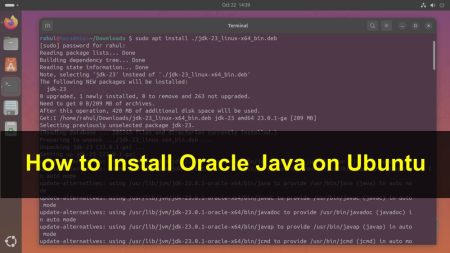Environment variables are a fundamental aspect of software development, offering a flexible and powerful way to configure applications. By understanding how to work with environment variables in Java, you can create efficient, scalable, and robust programs. In this comprehensive guide, we’ll explore the concepts of environment variables and their usage in Java applications. Let’s dive in!
Table of Contents
- Introduction
- Getting Environment Variables
- Setting Environment Variables
- Using Environment Variables in Build Tools
- Best Practices
- Conclusion
1. Introduction
Environment variables are key-value pairs that can be used to store and retrieve configuration information for applications. They provide a way to define settings that can be changed without modifying the application code. This approach allows developers to maintain a consistent configuration throughout different development, testing, and production environments.
Some common use cases for environment variables include:
- Configuring database connection strings
- Specifying API keys or secrets
- Defining paths to external resources or directories
- Controlling the behavior of the application based on the current environment (development, staging, production)
2. Getting Environment Variables
In Java, environment variables can be accessed using the System class. The System.getenv() method returns a map of the current environment variables, while System.getenv(String name) retrieves the value of a specific variable by its name.
Here’s an example of how to access environment variables in Java:
public class EnvironmentVariableExample {
public static void main(String[] args) {
// Get all environment variables
Map env = System.getenv();
for (String envName : env.keySet()) {
System.out.format("%s=%s%n", envName, env.get(envName));
}
// Get a specific environment variable
String javaHome = System.getenv("JAVA_HOME");
System.out.println("JAVA_HOME: " + javaHome);
}
}
3. Setting Environment Variables
Environment variables are typically set outside the Java application, either through the operating system or by using build tools. However, you can use Java to create or modify environment variables for child processes spawned by the Java application. This can be achieved using the ProcessBuilder class:
public class SetEnvironmentVariableExample {
public static void main(String[] args) throws IOException {
Map<String, String> env = new HashMap<>();
env.put("MY_VARIABLE", "myValue");
ProcessBuilder pb = new ProcessBuilder("myCommand");
pb.environment().putAll(env);
Process process = pb.start();
}
}
4. Using Environment Variables in Build Tools
Popular build tools, such as Maven and Gradle, allow you to configure environment variables for your Java projects. This section demonstrates how to set environment variables using Maven and Gradle.
Maven
Integrating environment variables into Maven projects enhances flexibility across different setups. For example, to use a variable for the database URL, add <database.url>${env.DATABASE_URL}</database.url> in the <properties> section of your pom.xml. This approach streamlines configurations for various environments without altering the core project file, promoting efficient development practices.
Here is an example pom.xml file that demonstrates how to integrate the environment variable DATABASE_URL:
<project xmlns="http://maven.apache.org/POM/4.0.0"
xmlns:xsi="http://www.w3.org/2001/XMLSchema-instance"
xsi:schemaLocation="http://maven.apache.org/POM/4.0.0 http://maven.apache.org/xsd/maven-4.0.0.xsd">
<modelVersion>4.0.0</modelVersion>
<groupId>com.example</groupId>
<artifactId>my-application</artifactId>
<version>1.0-SNAPSHOT</version>
<properties>
<!-- Using environment variable for the database URL -->
<database.url>${env.DATABASE_URL}</database.url>
</properties>
<dependencies>
<!-- Your project dependencies here -->
</dependencies>
<!-- Additional configurations like build plugins etc. -->
</project>
Gradle
In Gradle, leveraging environment variables enables dynamic configuration management, streamlining project setup across environments. For example, to access an environment variable like DATABASE_URL, use below:
apply plugin: 'java'
// Accessing environment variable
def databaseUrl = System.getenv('DATABASE_URL') ?: 'jdbc:default:url'
repositories {
mavenCentral()
}
dependencies {
// Your dependencies here
}
// Example usage in a task
task printDatabaseUrl {
doLast {
println "Database URL: $databaseUrl"
}
}
n this snippet, System.getenv(‘DATABASE_URL’) fetches the value of the DATABASE_URL environment variable. The ?: operator provides a default value (‘jdbc:default:url’) if DATABASE_URL is not set. This approach allows you to dynamically configure your Gradle project with environment-specific values, such as database URLs, enhancing flexibility across different development, testing, and production environments.
5. Best Practices
To ensure effective use of environment variables in your Java applications, consider the following best practices:
- Don’t hard-code sensitive information: Keep sensitive information, such as API keys and secrets, out of your source code by using environment variables. This helps protect your data and prevents accidental exposure through version control systems.
- Use descriptive variable names: Choose clear and descriptive names for your environment variables to improve code readability and maintainability. Follow a consistent naming convention, such as using uppercase letters and underscores for separation.
- Validate and handle missing variables: Your application should validate and handle cases where required environment variables are missing or have invalid values. Provide clear error messages and, if possible, offer default values or fallback options.
- Document your environment variables: Clearly document the purpose, possible values, and usage of each environment variable in your application. This documentation helps other developers understand and maintain your code, and can also aid in troubleshooting issues.
- Minimize the number of environment variables: While environment variables offer flexibility, using too many can make your application more difficult to configure and manage. Strive for a balance between flexibility and simplicity by using a minimal set of environment variables.
- Use configuration files for complex settings: If your application requires complex configuration settings, consider using a configuration file instead of environment variables. This approach can make it easier to manage and maintain your application’s settings.
Conclusion
Environment variables are a powerful and flexible way to configure Java applications. By understanding how to work with them effectively, you can create more efficient, scalable, and robust programs. This comprehensive guide covered the basics of accessing and setting environment variables, working with build tools, and best practices for their usage. Armed with this knowledge, you can now master environment variables in your Java development projects.

